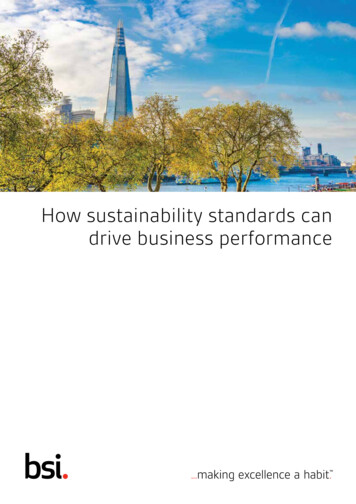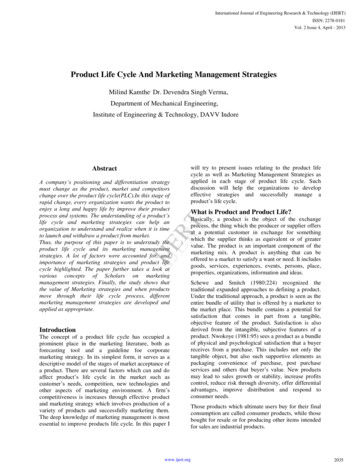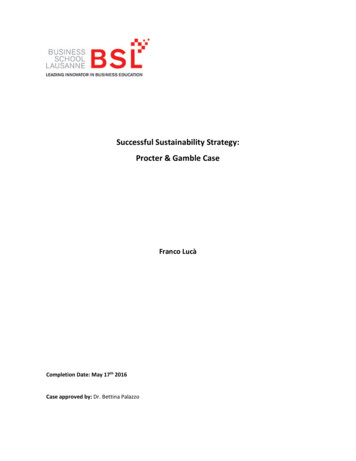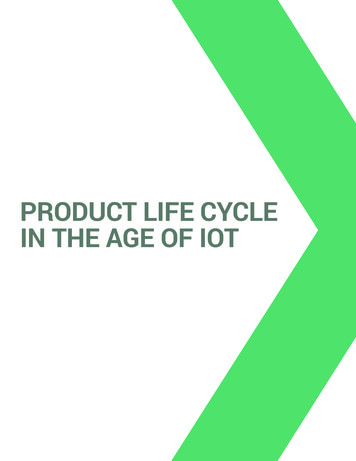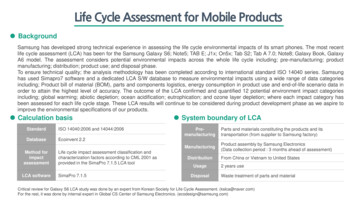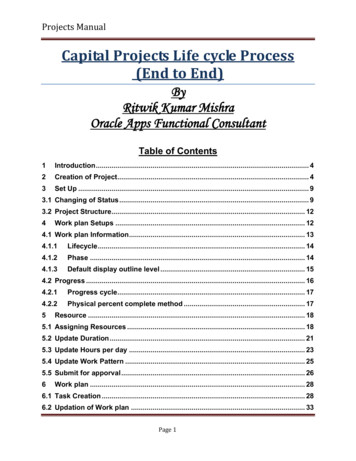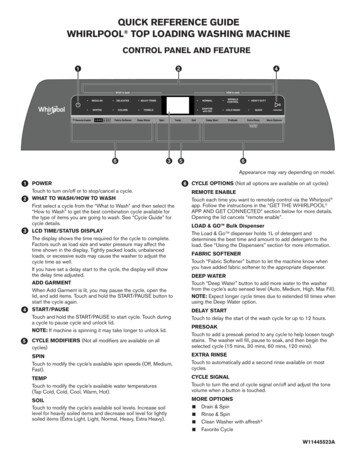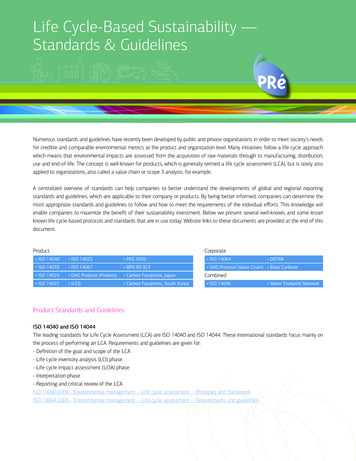
Transcription
Life Cycle-Based Sustainability —Standards & GuidelinesNumerous standards and guidelines have recently been developed by public and private organizations in order to meet society’s needsfor credible and comparable environmental metrics at the product and organization level. Many initiatives follow a life cycle approachwhich means that environmental impacts are assessed from the acquisition of raw materials through to manufacturing, distribution,use and end-of-life. The concept is well-known for products, which is generally termed a life cycle assessment (LCA), but is lately alsoapplied to organizations, also called a value chain or scope 3 analysis, for example.A centralized overview of standards can help companies to better understand the developments of global and regional reportingstandards and guidelines, which are applicable to their company or products. By being better informed, companies can determine themost appropriate standards and guidelines to follow and how to meet the requirements of the individual efforts. This knowledge willenable companies to maximize the benefit of their sustainability investment. Below we present several well-known, and some lesserknown life cycle-based protocols and standards that are in use today. Website links to these documents are provided at the end of thisdocument.ProductCorporate ISO 14040 ISO 14025 PAS 2050 ISO 14064 DEFRA ISO 14033 ISO 14067 BPX 30-323 GHG Protocol (Value Chain) Bilan Carbone ISO 14024 GHG Protocol (Product) Carbon Footprints, Japan ISO 14021 ILCD Carbon Footprints, South KoreaCombined ISO 14046 Water Footprint NetworkProduct Standards and GuidelinesISO 14040 and ISO 14044The leading standards for Life Cycle Assessment (LCA) are ISO 14040 and ISO 14044. These international standards focus mainly onthe process of performing an LCA. Requirements and guidelines are given for:- Definition of the goal and scope of the LCA- Life cycle inventory analysis (LCI) phase- Life cycle impact assessment (LCIA) phase- Interpretation phase- Reporting and critical review of the LCAISO 14040:2006 - Environmental management -- Life cycle assessment -- Principles and frameworkISO 14044:2006 - Environmental management -- Life cycle assessment -- Requirements and guidelines
ISO 14024 (Type I label)Voluntary, multiple-criteria based, third party program developed for a specific product or products. Examples include the EU ecolabel,Blue angel, Ecologo, etc.ISO 14024 - Type I LabelISO 14021 (Type II label)Type II is for any written or spoken environmental statement or claim. There are no fixed criteria, manufacturers simply declare theinformation they wish to communicate about the environmental attributes of their products.ISO 14021 - Type II LabelISO 14025 (Type III label)ISO 14025 is based on ISO 14040/44 and introduces two concepts: Product Category Rules (PCRs) and Environmental ProductDeclarations (EPDs). PCRs are specific guidelines for the calculation of the environmental impact of products with similar characteristics.By following the requirements in the PCR, a company can develop an EPD, which is concise document containing relevant environmentalinformation about a product.PCRs are subject to administration of a program operator. Examples of program operators are Environdec (located in Sweden, withinternational focus), PlasticsEurope (the Association of Plastics Manufacturers in Europe), Institut Bauen und Umwelt (Germany), EPDnorge (Norway) UL Environment (United States) and JEMAI (Japan). An overview of PCRs from various program operators can be foundat: http://pcr-library.edf.org.tw/index.asp. The site of program operator Environdec (http://www.environdec.com) also provides PCRs andin addition EPDs.ISO 14025:2006 - Environmental labels and declarations -- Type III environmental declarations -- Principles and proceduresDraft ISO 14067: Carbon Footprint of ProductThis standard is based on ISO 14040/44 and ISO 14025, but focuses on climate change only. Quantification of the carbon footprint ofa product (CFP) is largely based on ISO 14040/44, but includes requirements on specific issues relevant for carbon footprints, includingland-use change, carbon uptake, biogenic carbon emissions and soil carbon change. The standard also provides specific requirementson communication with or without the intention to be publicly available.Expected publication of this International Standard is the end of 2012.GHG Protocol Product Standard: Product Life Cycle Accounting and Reporting StandardThe GHG Protocol product standard has been developed by the World Resources Institute (WRI) and the World Business Councilon Sustainable Development (WBCSD) and was road tested by 60 companies in 2010. Like ISO 14067, this standard is largely incompliance with ISO 14040/44, but is specifically focused on greenhouse gas accounting. The standard includes many practicalexamples. The GHG Protocol product standard was launched in October 2011 and has been adopted as a basis for various industrydriven initiatives, including, The Sustainability Consortium1.GHG Protocol - Product Life Cycle Accounting and Reporting Standard1 The Sustainability Consortium (TSC) drives scientific research and the development of standards and IT tools, through a collaborative process, to enhance the ability to understandand address the environmental, social, and economic implications of products. The Sustainability Measurement and Reporting System (SMRS) under development will deliver actionablesustainability information through Category Sustainability Profiles (Level 1), and deliver a large-scale system supporting standardization and harmonization of product LCAs over time(Level 2).2
ILCD: International Reference Life Cycle Data SystemIn response to the commitments in the Integrated Product Policy (IPP) communication of the European Commission, the Joint ResearchCentre prepared the ILCD handbook to meet commitments which were made by the European Commission in the Integrated ProductPolicy (IPP) communication. The ILCD Handbook was published in 2010. It is based on ISO 14040/44, but provides much more detailedtechnical guidance. The ILCD Handbook contains over 400 pages, whereas ISO 14040/44 jointly contains about 60 pages. The ILCDHandbook contains detailed descriptions and requirements in order to reduce flexibility in choices and to support consistency andquality assurance of LCA results.At the moment, the Environment Directorate General and the Joint Research Center (JRC) are developing a harmonized methodologyfor the calculation of the environmental footprint of products and organizations. Both methods are based on the ILCD Handbook; PCRsare developed in parallel.International Reference Life Cycle Data System HandbookPAS 2050: UK’s Product Carbon Footprint StandardPAS 2050 was published by British Standards Institution (BSI) in 2008 and revised in October 2011. PAS 2050 was the first carbonfootprint standard and has been applied by many companies worldwide. The 2011 revision resulted in a standard that is largely alignedwith the GHG Protocol product standard.PAS 2050 - Life cycle greenhouse gas emissions of goods and servicesBPX 30-323: French Environmental Footprint GuidanceIn BPX 30-323, the French law Grenelle laid the framework and general methodology for French environmental product labeling. Beyondrequiring a carbon footprint for each product category, BPX 30-323 provides general guidelines for product-specific communication andis in line with ISO 14040/44. Additionally, BPX 30-323 includes guides for certain PCRs, and the Agency for Environment and EnergyManagement (ADEME) has begun development of a public database containing generic data.France is currently conducting national research on consumer product environmental information that started on 1 July 2011, and willlast one year with 168 participating companies. The pilot covers the quantification of environmental impacts and the communicationof environmental footprints to the consumer.BPX30-323: French Environmental Footprint GuidanceCarbon Footprint of Products, JapanFounded in 2008 by the Japanese Ministry of Economy, Trade and Industry, The Carbon Footprint of Products (CFP) Project sought todevelop a national system for the calculation of carbon footprint of products. A pilot program was conducted from 2009 to 2011 andover 250 products have been evaluated so far. In April 2012, the Japan Environmental Management Association for Industry took controlof the project and will continue to expand the program.Japan: Carbon Footprints of ProductsCarbon Footprint of Products, South KoreaAfter a pilot program in 2009 by the Korean Environmental Industry and Technology Institute, a carbon label was introduced in SouthKorea. The label is based on the UK labeling scheme and intends to adopt ISO 14067 when that standard is published, and a low-carbonlabel is being developed to allow for companies to further differentiate their products. Thus far over 350 products and services havebeen evaluated and have this label.South Korea: Carbon Footprints of Products3
Corporate Standards and GuidelinesISO 14064: Greenhouse Gases – Part 1, 2 and 3ISO 14064 specifies principles and requirements for the reporting of greenhouse gas (GHG) emissions at the both the organization andmore specifically at the project level. Part 1 focuses on the organisation level and part 2 at the project level. Part 3 provides guidancefor those conducting or managing the validation and/or verification of GHG assertions.ISO 14064: Greenhouse Gases - Part 1ISO 14064: Greenhouse Gases - Part 2ISO 14064: Greenhouse Gases - Part 3GHG Protocol Corporate Standards: Corporate and Scope 3The Corporate Value Chain (scope 3) standard was published in October 2011. The initial GHG Protocol Corporate Standard providesstandards and guidance for companies and other types of organizations preparing a GHG inventory for scope 1, 2 and 3 emissions.The scope 3 standard is a supplement to the Corporate Standard and focuses on the indirect emissions of organizations (excluding scope 2emissions; purchased electricity).GHG Protocol: Scope 3 StandardDepartment for Environment, Food and Rural Affairs (DEFRA) - Guidance on how to measure and report your greenhouse gas emissionsThe UK’s corporate GHG accounting guide assists organizations of all sizes in reporting their GHG emissions, either voluntarily or tosatisfy the requirements the Companies Act 2006. The goal of this guide is to allow companies to be proactive in managing andreducing their carbon emissions. Based on the GHG protocol, it also serves as a complement to both PAS 2050 and ISO 14040, whichare discussed previously in this overview and included extensive involvement with businesses. Minimum reporting recommendations areall scope 1 and 2 emissions, an intensity ratio, and a base year because factors annual adjustment factors are provided. While reportingof significant scope 3 emissions is not required, it is strongly encouraged. Beyond the reporting recommendations, the guidancecontains additional information on setting reduction targets and how to report convey additional information about reductions.DEFRA - GHG Emissions GuidanceBilan CarboneConstructed, by ADEME in France, Bilan Carbone is a GHG accounting guidance document and tool for any organization interested intheir greenhouse gas emissions. Currently, there are three distinct modules: companies, communities and territories, which makes thistool applicable to a wide range of entities from private companies to communities interested in urban planning. All greenhouse gasesare considered, rather than the six Kyoto Protocol GHGs considered in most guides, and indirect greenhouse gas emissions are alsoaccounted for.Bilan Carbone (in French)Combined Standards & Guidelines: Products and OrganizationsDraft ISO 14046: Water FootprintQuantification of water footprints for products, processes and organizations is under development since 2009. This standard takes alife cycle approach as in ISO 14040/44 but focuses on water solely.Expected publication of this International Standard is 2014.Water Footprint NetworkThe Global Water Footprint Standard is the outcome of a joint effort between the Water Footprint Network, its associated partners,and the University of Twente in the Netherlands. The standard is contained in the Water Footprint Assessment Manual and has beenrecognized as an important step in addressing global water problems. Broad guidelines on the specific phases of water footprintsranging from individual processes and products to the national level are provided in the manual.Water Footprint Network4
Websites for Further InformationStandard or InitiativeWebsiteBilan RANCAISBlue Angelhttp://www.blauer-engel.de/en/blauer engel/index.phpBPX arbon Footprint, Japanhttp://www.cfp-japan.jp/englishCarbon Footprint, South ogo.org/enEnvirondechttp://www.environdec.comEU HG Protocol uct-standardGHG Protocol (Value ine-12March2010.pdfISO 14021http://www.iso.org/iso/catalogue detail?csnumber 23146ISO 14024http://www.iso.org/iso/catalogue detail?csnumber 23145ISO 14025http://www.iso.org/iso/catalogue detail?csnumber 38131ISO 14040http://www.iso.org/iso/catalogue detail?csnumber 37456ISO 14044http://www.iso.org/iso/catalogue detail?csnumber 38498ISO 14064http://www.iso.org/iso/catalogue detail?csnumber 38381PAS Servic
Corporate Standards and Guidelines ISO 14064: Greenhouse Gases – Part 1, 2 and 3 ISO 14064 specifies principles and requirements for the reporting of greenhouse gas (GHG) emissions at the both the organization and more specifically at the project level. Part 1 focuses on the organisation level and part 2 at the project level. Part 3 provides guidance for those conducting or managing the .


